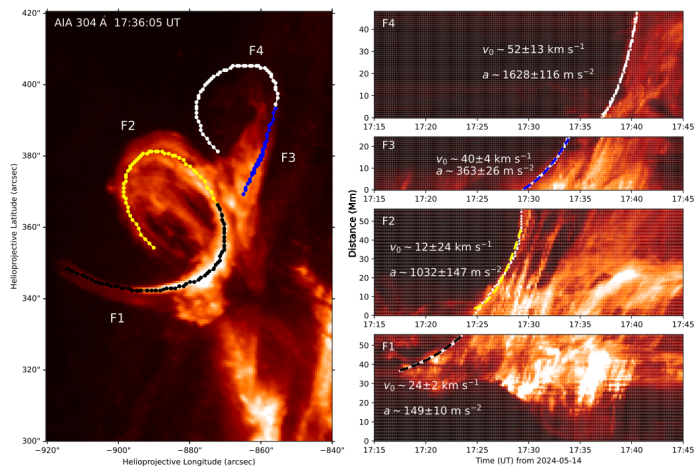Solar Rollercoaster: looping-the-loop in the solar corona
| Nugget | |
|---|---|
| Number: | 491 |
| 1st Author: | Mohamed NEDAL |
| 2nd Author: | et al. |
| Published: | 31 March 2025 |
| Next Nugget: | |
| Previous Nugget: | Proton Beam Energy Deposition as a Mechanism of Deep Photospheric Heating |
Introduction
The visual behavior of the solar corona, as viewed in white light, EUV, radio, and/or soft X-rays, guides us to an understanding of the plasma physics involved in a solar flare/CME event. In particular, spiral patterns in sunspot groups may have helped to guide Hale to the discovery of solar magnetism in the first place. Helicity in a 3D magnetized plasma may make such patterns in images.
We have observed a clearly helical flow during the CME associated with SOL2024-05-14 (Ref. [1]). In this study, we measured key plasma properties and provided fresh insights into the dynamics of the solar corona following the eruption. This Nugget depends on movies accessible in the paper's movies on line.
Key Observations and Measurements
The helical structure was visible for about 22 minutes and spanned nearly 184 megameters. The analysis of the helical motion shown in Figure 1 revealed that plasma speeds along the loops ranged from 77 to 384 km/s, with temperatures estimated between 3.5 and 10 MK and electron densities between 4.3e06 and 1.55e07 cm-3 (Figure 2). These quantitative results suggest that impulsive heating and plasma expansion along existing magnetic field lines play an important role in shaping the dynamics of the corona after a CME.
Implications for Solar Physics
The clear documentation of the helical motion and associated thermal and density variations enhances our understanding of magnetic reconnection and energy release in the corona. Such observations help refine models of CME-driven mass and energy transport, which are critical for accurate space weather predictions. By combining precise measurements of plasma speed, temperature, and density, this study provides a robust example of how solar eruptions can trigger organized, helical plasma flows. These findings contribute to a better understanding of the interplay between magnetic fields and plasma dynamics in the solar atmosphere.
Acknowlegements
This Nugget and Ref. [1] have co-authors D. M. Long, C. Cuddy, L. V. Driel-Gesztely, and P. T. Gallagher.
References
[1] "Helical flows along coronal loops following the launch of a coronal mass ejection"
[2] "Continuous tracking of coronal outflows: Two kinds of coronal mass ejection"

